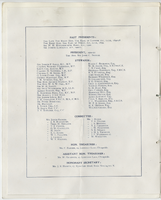Search the Special Collections and Archives Portal
Search Results

Correspondence, P.L. Williams to H.E. George
Date
Archival Collection
Description
Text
Cork Proctor Photograph Collection
Identifier
Abstract
The Cork Proctor Photograph Collection (1960s-1980s) primarily contains black-and-white photographic reproductions of early Las Vegas, Nevada; the Cal-Neva Lodge at Lake Tahoe, Nevada; and various celebrities. The collection also includes black-and-white photographic prints of the Helldorado Parade. Cork Proctor was a comedian who performed throughout Nevada and the United States.
Archival Collection
Stella Champo Iaconis Collection of Helldorado Photographs
Identifier
Abstract
The Stella Champo Iaconis Collection of Helldorado Photographs (approximately 1934-1940) contains four black-and-white photographic prints of the Helldorado Days celebration held in Las Vegas, Nevada. Images depict people celebrating at the Apache Bar in downtown Las Vegas.
Archival Collection
University of Nevada, Las Vegas Department of Anthropology and Ethnic Studies Records
Identifier
Abstract
The collection is comprised of the University of Nevada, Las Vegas (UNLV) Department of Anthropology and Ethnic Studies administrative records, memoranda, and correspondence dating from 1966 to 2006. The collection includes information about UNLV's department of Anthropology and Ethnic Studies from its inception at Nevada Southern University, its transition to UNLV, and research initiatives the department has undertaken.
Archival Collection
University of Nevada, Las Vegas Alumni Association Records
Identifier
Abstract
The University of Nevada, Las Vegas (UNLV) Alumni Association Records (approximately 1970-2009) primarily contain photographic prints of homecoming, graduation, award ceremonies, luncheons, career days, sports, and other events. Also included in the collection are photographic prints of UNLV merchandise, faculty, staff, students, and alumni, as well as subject files with correspondence, reports, brochures, university anniversary planning documents, promotional materials, meeting minutes, and newspaper clippings. Additional materials include contact sheets, negatives, a floppy disk, VHS tapes, a Betacam tape, and keychains.
Archival Collection
University of Nevada, Las Vegas Faculty Senate Records
Identifier
Abstract
The University of Nevada, Las Vegas (UNLV) Faculty Senate Records (1957-2001) primarily contain meeting agendas, minutes, correspondence, notices, and additional documents pertaining to the Nevada Southern University Faculty Senate and the UNLV Faculty Senate, as well as associated committees such as the Curriculum Committee, Graduate Program Evaluation Committee, and Status of Women Committee. The collection also includes constitutions, bylaws, handbooks, merit allocation lists, and reports.
Archival Collection
Nevada Consolidated Copper Company Photograph Albums
Identifier
Abstract
The Nevada Consolidated Copper Company Photograph Albums (1906-1907) contain two photograph albums from the mining company's chief engineer's office. The photograph albums include cyanotype and black-and-white photographs depicting the construction of the smelting plant, equipment, railroad, and landscape of Ruth, Nevada.
Archival Collection
Ricki Barlow City Council Papers
Identifier
Abstract
The collection is comprised of correspondence, maps, reports, and economic development plans from Ricki Barlow, the Las Vegas City Council representative for ward five, dating from 2006 to 2015. The collection includes information about development plans for West Las Vegas, Nevada and downtown Las Vegas, Nevada.
Archival Collection
Willard H. George Furrier, Ltd. Scrapbooks
Identifier
Abstract
The Willard H. George Furrier, Ltd. Scrapbooks are comprised primarily of three leatherbound scrapbooks containing black-and-white and sepia toned photographs taken from the 1920s through 1955. The scrapbooks feature actresses from Hollywood, California wearing furs designed and created by furrier Willard H. George. Actresses of note include Lucille Ball, Rita Hayworth, and Greta Garbo.
Archival Collection

